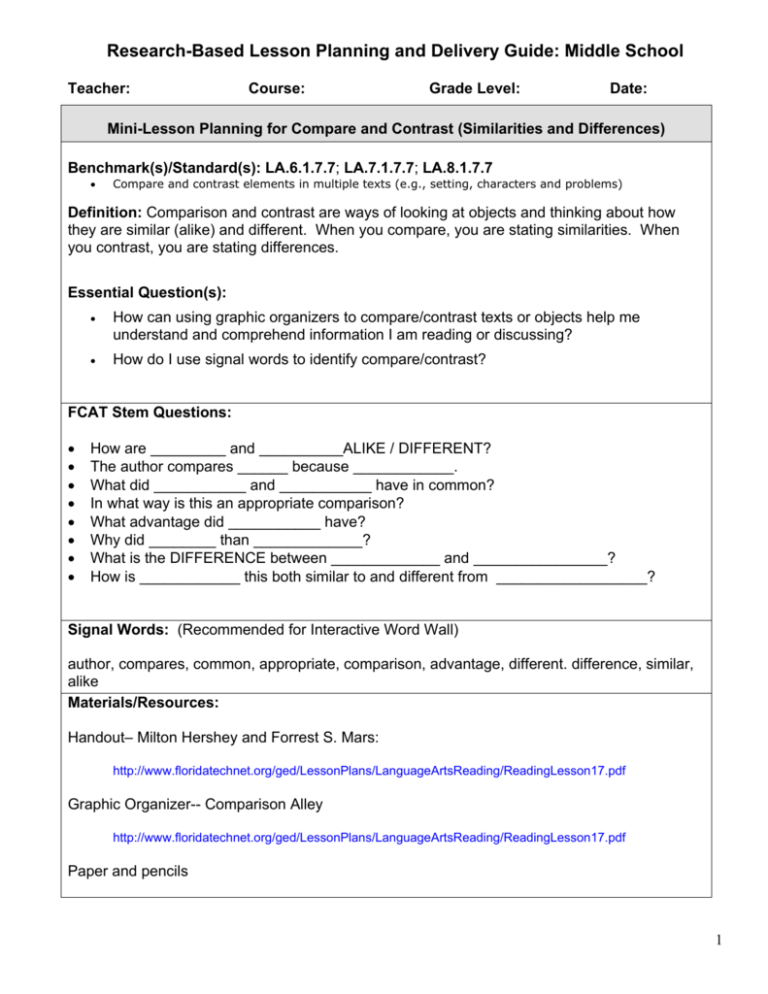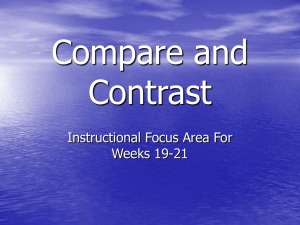Research-Based Lesson Planning and Delivery Guide: Middle
advertisement

Research-Based Lesson Planning and Delivery Guide: Middle School Teacher: Course: Grade Level: Date: Mini-Lesson Planning for Compare and Contrast (Similarities and Differences) Benchmark(s)/Standard(s): LA.6.1.7.7; LA.7.1.7.7; LA.8.1.7.7 • Compare and contrast elements in multiple texts (e.g., setting, characters and problems) Definition: Comparison and contrast are ways of looking at objects and thinking about how they are similar (alike) and different. When you compare, you are stating similarities. When you contrast, you are stating differences. Essential Question(s): • How can using graphic organizers to compare/contrast texts or objects help me understand and comprehend information I am reading or discussing? • How do I use signal words to identify compare/contrast? FCAT Stem Questions: • • • • • • • • How are _________ and __________ALIKE / DIFFERENT? The author compares ______ because ____________. What did ___________ and ___________ have in common? In what way is this an appropriate comparison? What advantage did ___________ have? Why did ________ than _____________? What is the DIFFERENCE between _____________ and ________________? How is ____________ this both similar to and different from __________________? Signal Words: (Recommended for Interactive Word Wall) author, compares, common, appropriate, comparison, advantage, different. difference, similar, alike Materials/Resources: Handout– Milton Hershey and Forrest S. Mars: http://www.floridatechnet.org/ged/LessonPlans/LanguageArtsReading/ReadingLesson17.pdf Graphic Organizer-- Comparison Alley http://www.floridatechnet.org/ged/LessonPlans/LanguageArtsReading/ReadingLesson17.pdf Paper and pencils 1 Links to other printable compare/contrast graphic organizers: http://teacher.scholastic.com/lessonrepro/reproducibles/profbooks/alikediff.pdf http://www.educationoasis.com/curriculum/GO/compare_contrast.htm Lesson Agenda: FCIM Mini-Lesson Sequence Day One: Explicit Instruction (10 min) Day Two: Modeled Instruction (15 min) Day Three: Guided Practice (15 min) Day Four: Independent Practice (10 min) Day Five: Mini-Assessment (10 min) & Review Student Responses Special Note: These FCIM Mini-lessons should be delivered for 10-15 minutes at the beginning of the class for the first school days of the month of August. The District’s monthly focus skill does not align with the curriculum map timelines for reading. Please understand that it is the District expectation that every teacher adhere to the monthly focus skill calendar in addition to following your content’s curriculum map timelines. Mini-Lesson Delivery for Compare and Contrast (Similarities and Differences) 2 Day 1- Explicit Instruction: How will I focus my students on what they need to learn? What important vocabulary will I introduce/review? Signal Words to be added to the interactive Word Wall: Comparison/contrast, cause/effect, chronological order/chronology, argument/support, problem/solution, alike/different Explain: The ability to compare and contrast information can help a student in many areas of his/her life. Students need to compare and contrast products that they purchase, so they get the most for their money. They also need to compare and contrast information from various sources when making decisions about their lifestyles, diet, nutrition, etc. Activating Strategy: Say: Being able to compare and contrast information can help you in many areas of your life. Ask: Have you ever done comparison shopping? Why did you do that? Say: Most likely you comparison shopped so you could make decisions about which product was the best buy. This same process can help you as you read. Pick two common examples: Burger King vs. McDonald’s Hollister vs. Baby Phat Honda vs. Acura Pepsi vs. Coke Day Two-- Modeled Instruction: How will I show my students what they are expected to do to answer the essential question(s)? Read Aloud– Excerpts about the lives of Milton Hershey and Forrest S. Mars Activity: Distribute copies of the excerpts about the lives of Milton Hershey and Forrest S. Mars. Have students use the Comparison Alley graphic organizer to compare and contrast the lives of each of the men. Day 3- Guided Practice: How will I help my students practice answering the essential question(s)? (How will I incorporate Teacher-Led Question and Answer, Student Accountable Talk, Collaborative Structures, and Checks for Understanding? 3 Activity: Conduct a Think-Aloud* about how Milton and Mars are alike. Discuss the similarities and differences in the lives of the two men. Have students discuss how the men were possibly influenced by their parents, and how that may or may not have affected the success they experienced in their professional lives. Review and modify Comparison Alley graphic organizer from Day 2. *A Think Aloud is an oral verbalization strategy in which the teacher verbalizes aloud while reading a selection orally, thus modeling the process of comprehension. Day 4- Independent Practice: How will my students practice answering the essential question(s)? Pair up the students, giving each student pair a blank Venn Diagram. Have them complete the diagram listing the ways they are similar and different. (Collaborative Structure) Alike and Different Graphic Organizer: http://teacher.scholastic.com/lessonrepro/reproducibles/profbooks/alikediff.pdf Additional strategies/activities: • Repeat the above exercise using another type of organizer or content area strategy. • Give students two pieces of short text to read OR provide students with a brief list of selections with which they are familiar and have them compare/contrast the selections using one of the graphic organizers. • Do a Word Splash vocabulary activity using the compare/contrast signal words. • A/B partner Review: Pairs Review—Partner A talks for one minute about everything he/she has learned about compare/contrast (similarities and differences). After one minute, Partner B talks for one minute, trying to follow the rule of no repeats. • With a partner, complete a Compare & Contrast Word Map graphic organizer (What is it? What is it like? What are some examples?) • Display two pictures for students (or use examples from math, science, social studies, or content texts). Have pairs use one of the graphic organizers to compare/contrast the two pictures. • Compare and contrast two familiar stories or other familiar text (use content area texts as well). Students complete a graphic organizer (Venn, Same/Different, Double Bubble). Students should be able to answer the following questions: How are the two stories similar? Different? How are the endings alike? Different? Day 5- Assessment: How will I know if my students can answer the essential question(s)? Have students compare and contrast different times in their lives, indicating how things are the same and how they are different from 1 year ago, 3 years ago, 10 years ago, etc. Using the Have the students complete a summarizing activity through which they answer the essential 4 questions for the mini-lessons. Examples: 3-2-1 Journal Exit Ticket Anticipation Guide 5







